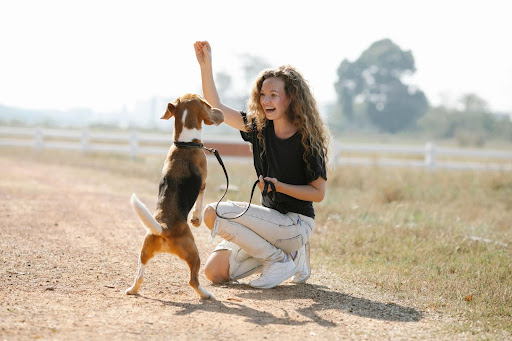Training a service dog involves a combination of patience, expertise, and a keen understanding of how dogs think and behave..Whether you’re looking to train a service dog for personal needs or to start a career in professional dog training, this guide will walk you through the essential steps.
Along the way, we’ll also show you how partnering with a trusted franchise like Kontota Franchising can give you the support needed to succeed in the pet care industry, including mobile dog grooming franchises that align perfectly with service-based animal care.
What is Service Dog Training?
Service dog training is a specialized process that teaches dogs to assist individuals with disabilities or specific medical conditions. These specially trained dogs assist with tasks such as helping those with visual impairments navigate, warning individuals with epilepsy about impending seizures, and offering emotional comfort to those coping with PTSD.
Unlike obedience training, service dog training is much more intensive and requires the dog to master complex tasks consistently in public settings.
Key Traits of a Great Service Dog
Not all dogs are inherently fit for service roles. While many breeds have the potential, it’s the individual temperament and trainability that matter most. If you’re planning to train a service dog—either your own or a new pup—pay close attention to these essential qualities:
1. Calm and Steady Temperament
Service dogs need to stay calm and focused in diverse settings, from bustling streets and crowded malls to noisy events and peaceful offices. Dogs that startle easily or become anxious in unpredictable situations may not be ideal candidates. A steady temperament helps the dog stay focused and confident even in unfamiliar or high-pressure scenarios.
2. Strong Desire to Learn
A service dog must be able to learn and remember commands swiftly. Dogs that are curious, attentive, and eager to please tend to perform better in training. Their ability to consistently follow cues makes them reliable companions for people with disabilities or special needs.
3. Excellent Focus and Attention Span
Service dogs can’t afford to be distracted by every passing scent or squirrel. High concentration levels allow them to remain alert to their handler’s needs, especially during emergencies. This trait is vital for dogs that must perform life-saving or complex tasks.
4. Natural Affection and Loyalty
A strong bond with their handler is what turns a good dog into a great service dog. Dogs that are naturally affectionate, loyal, and responsive to human emotion are better equipped to provide emotional support, detect anxiety episodes, or respond to medical conditions.
If you’re unsure how to assess these traits or want professional help in training, Kontota Franchising can offer guidance through its service-based pet care programs.
Essential Steps to Begin Service Dog Training
1. Start with Socialization
Introduce the dog to different surroundings, noises, people, and other animals. This ensures they stay calm and collected regardless of where they are.
2. Teach Basic Commands
Before diving into complex tasks, your dog must master commands like “sit,” “stay,” “heel,” and “come.”
3. Move into Task-Specific Training
Depending on the disability or condition, train the dog to perform specific tasks like opening doors, alerting for help, or retrieving items.
4. Public Access Training
Service dogs must behave impeccably in public. They need to remain focused even in high-traffic areas or when distracted.
5. Certification and Testing
While there’s no universal license for service dogs, many trainers and handlers choose to certify their dogs through reputable organizations to validate their training.
Mobile Services: The Future of Dog Care
Many service dog trainers are combining their expertise with mobile grooming or training services. This trend not only offers convenience but also creates an excellent opportunity for aspiring entrepreneurs.
If you’re looking to build a career in this space, our Mobile Dog Grooming Franchise model provides a scalable and accessible business option. With rising demand and consumer convenience at its core, it’s a smart step for anyone passionate about working with dogs.
Choosing the Right Training Methods
When it comes to service dog training, the methods you use are just as important as the dog’s natural traits. The best training approaches are those that build trust and respect, encouraging a strong working relationship between the dog and handler. Here are some key methods that consistently yield success:
1. Positive Reinforcement
This technique involves rewarding the dog for correct behavior, whether it’s with treats, praise, or playtime. Positive reinforcement helps the dog associate desired behaviors with good outcomes, making them more likely to repeat those actions.It fosters a sense of accomplishment and encourages the dog to remain focused and motivated during training.
2. Clicker Training
Clicker training is a popular method that uses a distinct sound (the “click”) to mark desired behaviors. The click is immediately followed by a reward, helping the dog understand which specific action led to the positive outcome. This method helps dogs learn quickly by providing precise feedback.
3. Consistency and Repetition
Service dog training requires a steady, repetitive approach. Dogs learn best when commands and behaviors are practiced regularly and consistently. This helps the dog solidify their understanding and respond reliably in any situation.
4. Avoid Punishment-Based Techniques
Harsh training methods, such as using physical punishment or intimidation, can undermine the dog’s confidence. These methods may cause fear, anxiety, or aggression, which are counterproductive for service dogs. Focus on positive, constructive training to foster a confident, well-behaved service dog.
By using these positive techniques, you’ll be on the path to training a well-adjusted and effective service dog.
Tools That Make Training Easier
Invest in high-quality equipment such as:
- Harnesses with service dog patches
- Training treats
- Clickers
- Interactive toys
Using the right tools from the beginning makes training smoother and more enjoyable for both the trainer and the dog.
Benefits of Service Dog Training as a Business
If you’re passionate about animals and helping others, a business in service dog training can be deeply rewarding. Here’s why:
- High demand – More people are recognizing the value of service dogs
- Low overhead – Especially when combined with mobile services
- Flexible schedule – You choose your clients and hours
- Emotional fulfillment – Helping people improve their lives through trained dogs is incredibly gratifying
Real-World Application: Combining Services for Maximum Impact
Many successful entrepreneurs in this field combine training services with grooming, dog walking, or pet-sitting. A Mobile Dog Grooming Franchise like the one offered at Kontota allows you to diversify your income while maintaining a strong client base.
This strategy works well because you already have access to dog owners who value high-quality pet care. Offering them multiple services builds trust and long-term relationships.
Why Kontota Franchising is Your Ideal Partner
At Kontota, we don’t just offer franchise opportunities, we offer full support from day one.
- Hands-on training and operations support
- Marketing materials and brand recognition
- A proven business model backed by results
Joining our network means becoming part of a growing brand that genuinely cares about pets, their owners, and your success.
Final Thoughts
Service dog training is a rewarding path that combines skill, compassion, and opportunity. Whether you’re starting from scratch or looking to grow an existing business, having the right support system is key.
FAQs About Service Dog Training
Q1: How long does it take to train a service dog?
It can take anywhere from 6 months to 2 years, depending on the tasks and dog breed.
Q2: Can I train my service dog?
Yes, but it requires time, patience, and consistent effort. Professional guidance is often recommended.
Q3: Do service dogs need certification?
There is no legal requirement for certification, but it helps establish credibility, especially in public spaces.
Q4: What’s the best breed for a service dog?
Labrador Retrievers, Golden Retrievers, and German Shepherds are commonly used due to their temperament and trainability.
Q5: Can I combine service dog training with grooming services?
Absolutely. It’s a great way to diversify income and build long-term client relationships. Consider exploring a Mobile Dog Grooming Franchise with Kontota for added support.





